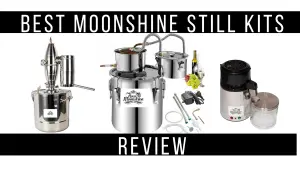Learn how to determine moonshine alcohol content with our simple step-by-step guide.
What Is Moonshine?
Moonshine is a term commonly used to refer to homemade or illicitly produced alcohol. It gained its name during the Prohibition era when individuals would secretly produce and distribute their own alcohol in order to avoid government regulations.
Moonshine is typically made through the fermentation process, where sugars are converted into alcohol. It is not refined or aged like commercial alcohol and often has a higher alcohol content.
Because moonshine is homemade, the alcohol concentration can vary greatly depending on the production methods used.
To determine the proof of moonshine, one can use simple tools like a hydrometer or a copper parrot to measure the alcohol percentage by volume.
These tools ensure accurate readings by measuring the density of the liquid and comparing it to the density of water.
By following proper safety precautions, individuals can ensure that their homemade moonshine is of the desired alcohol strength before enjoying it responsibly.
Why Knowing Alcohol Content is Important
Knowing the alcohol content of your moonshine is important for several reasons. Unlike commercial beverages, moonshine is often produced in homemade or small-scale operations, which can result in variations in alcohol content from batch to batch.
By knowing the alcohol content, you can ensure the consistency and safety of your product.
Historically, measuring the alcohol content in moonshine has been crucial. Moonshine originated during the prohibition era in the United States when the production and sale of alcohol were illegal.
To ensure the potency of their products, individuals would measure the alcohol content using a method called proofing.
Proofing is a measurement system used to determine the alcohol content in spirits. In the US, the proof is defined as twice the alcohol by volume (ABV), while in the UK, it is defined as 1.75 times the ABV.
By measuring the proof of moonshine, you can determine its strength and compare it to commercially available spirits.
There are various methods for measuring alcohol content, including using a proofing hydrometer or taking a gravity reading during the fermentation process.
These simple tools provide accurate readings of the potential alcohol content and help you determine the appropriate proof for your moonshine.
Knowing the alcohol content of your moonshine is essential for consistency, safety, and ensuring its quality matches commercial beverages.
Understanding the historical significance of proof measurement systems can help you appreciate the process and efforts put into your homemade moonshine.
How Stills Affect Your ABV

Pot stills will give you a product in the 130 to 150proof range. Reflux stills, which are quite popular these days, get the proof all the way up to the range of 160 to 190proof.
That’s pretty high, and these are giving you a really high-grade spirit that is neutral in flavor but high in moonshine alcohol content.
In this article, you’ll learn just how easy it is to determine the alcohol content of the moonshine you would be soon drinking.
Before We Get Started Let’s Check if We Have Everything You Need
For the Best Equipment, Check out Our Starter Kit:
Get All Your Moonshine Grain in one Easy Place. We Even Have Grain Kits!
Are You Ready for a Magnum?
What You’ll Need to Determine Moonshine Alcohol Content
There are a few different ways you could determine the moonshine alcohol content. The first way is a generic way that will tell you it’s either high or low, and you’ll never have an exact number such as 10% alcohol or 60% alcohol. This method is called the Shake Test. It’s good if you’re vacationing and left your tools of the trade at home.
Tools Needed for Measuring Moonshine Alcohol Content
When it comes to measuring the alcohol content in moonshine, having the right tools is essential. Accurate measurements not only help you determine the strength of your moonshine but also ensure that you are producing a high-quality product. Here are some of the key tools you will need for measuring moonshine alcohol content:
1. Proofing Hydrometer: A proofing hydrometer is a handy device that measures the specific gravity of your moonshine. By comparing the starting gravity and the final gravity of your moonshine, you can calculate its alcohol content. This tool is crucial for determining the proof and ABV of your moonshine accurately.
2. Copper Parrot: A copper parrot is a small device that fits on top of your moonshine still. It collects and measures the alcohol vapors produced during the distillation process. This allows you to obtain real-time proofing and ABV readings as your moonshine is being distilled.
3. Mason Jar:
A simple mason jar can be used as a makeshift tool for measuring the alcohol content of your moonshine.
Fill the jar with your moonshine and let it settle for a period of time. As the alcohol and water separate, you can visually estimate the proof based on the different layers formed.
4. Spirit Hydrometer: Similar to a proofing hydrometer, a spirit hydrometer measures the specific gravity of your moonshine. It helps determine the alcohol content accurately and is a reliable tool for measuring the strength of your moonshine.
By using these tools, you can ensure that your moonshine is produced at the desired proof and ABV levels. Remember to handle and use them with care to obtain precise and consistent measurements.
Hydrometer
A hydrometer is an essential tool for measuring the alcohol content of moonshine. There are two types of hydrometers commonly used: a brewing hydrometer and a proofing hydrometer.
A brewing hydrometer measures the specific gravity of the liquid, which indicates the potential alcohol content. It typically has a scale ranging from 0.990 to 1.170. By taking a gravity reading before and after the fermentation process, you can determine the potential alcohol content of your moonshine.
On the other hand, a proofing hydrometer is specifically designed to measure the actual alcohol content, or proof, of your moonshine. It has a scale ranging from 0 to 200 proof, with each increment representing 0.1% alcohol by volume (ABV). By taking a proof reading using a proofing hydrometer, you can accurately determine the alcohol strength of your moonshine.
To use a hydrometer, simply fill a cylinder with your moonshine sample and carefully lower the hydrometer into the liquid. Make sure the hydrometer is floating freely without touching the sides of the cylinder. Take a reading where the liquid meets the hydrometer’s scale, and record the value.
By comparing the initial and final readings from a brewing hydrometer or using a proofing hydrometer, you can accurately calculate the potential and actual alcohol content of your moonshine. This information is crucial for ensuring the desired strength and quality of your homemade spirit.
Mason Jar
When it comes to measuring the alcohol content of moonshine, sometimes a simple tool like a mason jar can come in handy. To use a mason jar for measuring moonshine alcohol content, carefully fill it with your moonshine sample, leaving some room for shaking.
Moonshiners often shake the jar to check the proof of alcohol.
By observing the size and duration of the bubbles that form when shaking the jar, they can get an idea of the alcohol content.
The larger and longer-lasting the bubbles, the higher the proof.
But why do moonshiners shake the jar? The answer lies in the surface tension of water. In a liquid with a higher alcohol concentration, the surface tension is reduced, leading to larger and longer-lasting bubbles.
By shaking the jar, moonshiners are disturbing the liquid and allow the bubbles to form, making it easier to determine the alcohol content.
While using a mason jar for measuring alcohol content might not give you the same precise readings as a hydrometer, it can provide a quick and simple way to check the proof of your moonshine.
Just remember to use caution when handling strong spirits and always check the proper permits and regulations for distillation.
Copper Moonshine Parrot (Optional)
When it comes to measuring the alcohol content of moonshine, a Copper Moonshine Parrot is an invaluable tool. This specially designed apparatus is used in conjunction with a hydrometer to accurately determine the proof of the moonshine.
A Copper Proofing Parrot is preferred for this task due to its construction from the same material as the still. This not only imparts a unique flavor to the moonshine but also allows for even heat distribution during the distillation process. By attaching the parrot to the still, the distilled spirit flows through it, providing an accurate measurement of the alcohol content.
To use a Copper Moonshine Parrot, simply insert the hydrometer into the parrot and allow the moonshine to flow through. The hydrometer, which measures the specific gravity or density of the liquid, will give you a reading that can be converted into proof. This allows moonshiners to ensure that their product is of the desired strength and potency.
In conclusion, a Copper Moonshine Parrot is an essential tool for measuring the alcohol content of moonshine. By combining it with a hydrometer, moonshiners can accurately determine the proof of their distilled spirits and produce high-quality moonshine.
Understanding ABV and Proof Levels
When it comes to moonshine and other alcoholic beverages, understanding the alcohol by volume (ABV) and proof levels is essential. ABV is a measure of the amount of alcohol in a specific volume of liquid, usually expressed as a percentage.
Proof, on the other hand, is simply twice the ABV. For example, a 40% ABV whiskey would be 80-proof. To accurately determine the proof of moonshine, a proofing hydrometer can be used. This simple tool measures the specific gravity or density of the liquid and provides an accurate reading that can be used to calculate the proof.
It’s important to remember that the ABV and proof levels of moonshine can vary depending on the fermentation process and the quality of the distillation. By understanding these levels and using proper tools, moonshiners can ensure that their homemade moonshine is of the desired strength and potency.
Alcohol By Volume (ABV)
Alcohol By Volume (ABV) is a crucial measurement when it comes to determining the alcohol content in a drink, such as moonshine. It is expressed as a percentage and indicates how much of the total volume of the drink is made up of alcohol. ABV is used to assess the strength and potential effects of alcoholic beverages.
To understand the alcohol content of moonshine, it is important to know the concept of alcohol proof. Alcohol proof is simply double the percentage of ABV. For example, if a moonshine has an ABV of 40%, its alcohol proof would be 80.
In the United States, the legal limit for alcohol proof is generally 200, while in other countries, it may vary. Spirytus, a Polish vodka, holds the record for the highest proof at a staggering 192. This means it contains 96% ABV.
To determine the proof of moonshine, one can utilize a proofing hydrometer or a brewing hydrometer. These simple tools measure the specific gravity or density of the liquid and provide insights into the alcohol content. By comparing the initial and final gravity readings, one can calculate the potential alcohol content and thus determine the proof of the moonshine.
By understanding the concept of ABV and using the appropriate tools, you can accurately measure the alcohol content of moonshine and ensure its quality and potency.
Alcohol Proof Levels
Alcohol proof levels play a crucial role in determining the strength of moonshine. The proof is calculated by doubling the percentage of alcohol by volume (ABV). For instance, if a moonshine has an ABV of 40%, its alcohol proof would be 80.
In the United States, there is a legal limit for alcohol proof, generally set at 200. This means that the highest proof alcohol can have is 200. However, other countries may have different limits. For example, Spirytus vodka, a well-known Polish brand, holds the record for the highest proof with an astonishing 192. This means it contains a massive 96% ABV.
Knowing the legal maximum proof in the United States helps ensure that moonshiners do not produce high-proof alcohols that could be dangerous.
By adhering to these regulations, individuals can create moonshine with a safe and acceptable level of alcohol strength.
Understanding alcohol proof levels is essential for moonshiners and consumers alike. It allows for the enjoyment of homemade spirits while ensuring they are safe to drink.
So, whether you’re making your own moonshine or enjoying a store-bought brand, remember to keep an eye on the alcohol proof levels to ensure a safe and enjoyable experience.
Potential Alcohol Content (PAC)
Potential Alcohol Content (PAC) is a crucial factor in determining the strength of moonshine. It is a measure of the maximum alcohol content that can be achieved during the fermentation process. By understanding PAC, moonshiners can ensure they produce a batch of moonshine with the desired alcohol strength.
To calculate PAC, a gravity reading is taken before and after fermentation. The gravity reading measures the density of the liquid and indicates how much sugar is present in the mixture. By comparing the gravity readings, one can determine the difference in potential alcohol between water and moonshine.
The difference in potential alcohol is then used to calculate the maximum alcohol strength in the moonshine. This is done by multiplying the difference by a conversion factor, which is usually provided by the manufacturer of the hydrometer or brewing instrument being used.
By knowing the PAC, moonshiners can take appropriate measures during the fermentation process to achieve the desired alcohol content.
It is important to note that PAC is just a measure of the maximum alcohol strength that can be obtained and may not reflect the actual alcohol content. Other factors like the distillation process and the proofing hydrometer used can also affect the final proof of moonshine.
Understanding the potential alcohol content is essential in producing moonshine with the desired alcohol strength. By calculating the PAC using the gravity reading and conversion factor, moonshiners can effectively monitor and control the fermentation process to achieve the desired results.
The Density of Water vs. Moonshine
The density of a liquid is a measure of how tightly packed its molecules are. In the case of water, it has a density of 1 gram per milliliter (g/mL). Moonshine, on the other hand, can have a higher density due to its alcohol content. This is because alcohol is less dense than water, causing the overall density of moonshine to be lower than that of water.
The density of moonshine is directly related to its alcohol content. As the alcohol content increases, the density of the liquid decreases. This is why moonshine floats on top of the water when the two are mixed together. The higher the alcohol content, the more likely the moonshine is to float on water.
Several factors influence the density of moonshine. One factor is the type of alcohol used in the fermentation process. Different types of alcohol have different density levels, which can affect the overall density of the moonshine. Another factor is the fermentation process itself, as the conversion of sugar to alcohol can also affect the density. Additionally, any impurities or additions to the moonshine can alter its density.
In conclusion, the density of moonshine is lower than that of water due to its alcohol content. The type of alcohol used and the fermentation process can also impact the density of moonshine. By understanding these factors, one can gauge the alcohol content of moonshine through its density.
Proofing Your Moonshine with a Hydrometer
Moonshine enthusiasts often use a hydrometer to determine the proof, or alcohol content, of their homemade concoctions. A hydrometer is a simple tool that measures the density of a liquid.
By taking a gravity reading before and after fermentation, you can calculate the percentage of alcohol and determine the proof of your moonshine.
To begin, fill a cylinder with your batch of moonshine, making sure it is deep enough to completely immerse the hydrometer.
Gently lower the hydrometer into the liquid, being careful not to let it touch the sides or bottom of the cylinder. Allow the hydrometer to settle and take a reading at eye level where the liquid meets the scale.
Compare this reading to a chart, which will provide the corresponding percentage of alcohol. If necessary, make adjustments and repeat the process until you achieve the desired proof.
It’s important to note that air bubbles can cause inaccurate readings, so be sure to tap the cylinder gently or let it sit for a few minutes to allow any bubbles to disperse.
With a hydrometer in hand, you can ensure the proper proof of your moonshine, giving you the confidence to enjoy your homemade creation responsibly.
Step 1: Preparing the Sample for Testing
Before you can determine the alcohol content of your moonshine, you need to properly prepare the sample for testing. Follow these steps to ensure accurate readings:
1. Choose a Trial Jar: Start by selecting a trial jar that is specifically designed for hydrometer readings. These jars are typically made of glass and have a narrow opening at the top.
2. Fill the Trial Jar: Pour your moonshine into the trial jar, filling it up to about 35mm from the top. This will provide enough liquid for the hydrometer to float freely without overflowing.
3. Use a Hydrometer: Place the hydrometer gently into the trial jar, making sure it is fully immersed in the moonshine. The hydrometer will measure the density of your moonshine and help determine the alcohol content.
4. Consider Liquid Temperature: For accurate readings, ensure that the moonshine sample has a temperature of 20°C (68°F). It’s important to take into account the temperature because it can affect the density and, consequently, the alcohol content measurement.
By following these steps, you will be able to prepare your moonshine sample for testing accurately using a hydrometer. Remember to take the necessary precautions and ensure that you have the proper permits if you are distilling your own moonshine.
Step 2: Taking a Gravity Reading
Once you have filled the trial jar with your moonshine, it is time to take a gravity reading. This reading will help determine the alcohol content of your moonshine.
1. Ensure Hydrometer Accuracy: Before taking the gravity reading, make sure your hydrometer is properly calibrated. Check the hydrometer’s calibration by placing it in distilled water. It should read 1.000. If it does not, adjust the readings accordingly.
2. Insert the Hydrometer: Gently place the hydrometer into the trial jar, ensuring that it is fully immersed in the moonshine. Make sure there are no air bubbles clinging to the hydrometer, as this can affect the accuracy of the reading.
3. Read the Gravity: Allow the hydrometer to come to rest in the moonshine. Take the gravity reading at eye level, where the liquid level intersects with the hydrometer scale. The gravity reading will typically be a fractional number, such as 1.050.
4. Calculate ABV or Proof: To determine the alcohol content of your moonshine, you will need to use a formula. There are different formulas for ABV (Alcohol By Volume) and proof calculations based on the gravity reading. You can find these formulas online or consult a reputable moonshine resource.
By taking a gravity reading with your hydrometer, you will be able to determine the alcohol content of your moonshine, allowing you to enjoy your homemade creation responsibly.
Step 3: Calculating ABV or Proof Level
Once you have obtained the gravity reading of your moonshine, it is time to calculate the alcohol content, either in terms of ABV (Alcohol By Volume) or proof level.
ABV represents the percentage of alcohol in the liquid, while proof is twice the ABV. For example, if your moonshine has an ABV of 40%, its proof would be 80.
To calculate the ABV or proof level, you will need to use a formula based on the gravity reading obtained in Step 3. Different formulas are available online or through reputable moonshine resources.
Here is a general formula for calculating ABV:
ABV = (Initial Gravity – Final Gravity) * 131.25
To determine the proof level, you can simply double the ABV. For example, if the ABV of your moonshine is calculated to be 50%, its proof would be 100.
Remember, the accuracy of the calculation depends on the precision of the gravity reading and the correct usage of the formula. If you are unsure, it is always advisable to consult a moonshine expert or reference material to ensure accurate calculations.
By calculating the ABV or proof level of your moonshine, you can better understand its alcohol content and potency, ensuring a safe and enjoyable experience.

Other Questions About Determining Moonshine Alcohol Content
From all this information, you can easily answer the following questions:
Is moonshine 100 percent alcohol?
Rarely. It may be as high as 192proof or 96% alcohol, and that’s pretty high.
Is homemade moonshine safe to drink?
Depending on the alcohol content, you may want to dilute the moonshine with water to make it less potent.
How strong is moonshine alcohol?
It ranges from pretty strong to not as strong. Much moonshine can be as low as 40 or 60 proof.
Does moonshine get you drunk?
It can, depending on the proof level.
What should you use to dilute the alcohol?
Distilled water.
Is Everclear stronger than moonshine?
Everclear is 190proof. Thus, depending on your still, you can approach 190 proof with your moonshine.





